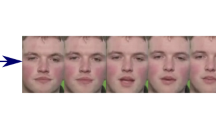Abstract
This paper presents a photo realistic facial animation synthesis approach based on an audio visual articulatory dynamic Bayesian network model (AF_AVDBN), in which the maximum asynchronies between the articulatory features, such as lips, tongue and glottis/velum, can be controlled. Perceptual Linear Prediction (PLP) features from audio speech, as well as active appearance model (AAM) features from face images of an audio visual continuous speech database, are adopted to train the AF_AVDBN model parameters. Based on the trained model, given an input audio speech, the optimal AAM visual features are estimated via a maximum likelihood estimation (MLE) criterion, which are then used to construct face images for the animation. In our experiments, facial animations are synthesized for 20 continuous audio speech sentences, using the proposed AF_AVDBN model, as well as the state-of-art methods, being the audio visual state synchronous DBN model (SS_DBN) implementing a multi-stream Hidden Markov Model, and the state asynchronous DBN model (SA_DBN). Objective evaluations on the learned AAM features show that much more accurate visual features can be learned from the AF_AVDBN model. Subjective evaluations show that the synthesized facial animations using AF_AVDBN are better than those using the state based SA_DBN and SS_DBN models, in the overall naturalness and matching accuracy of the mouth movements to the speech content.







Similar content being viewed by others
References
Abboud B, Davoine F, Dang M (2004) Facial expression recognition and synthesis based on an appearance model. Sig Process: Image Commun. doi:10.1016/j.image.2004.05.009
Bilmes J, Zweig G (2002) The graphical models toolkit: an open source software system for speech and time series processing. Proc IEEE Int Conf Acoust, Speech, Signal Process 4:3916–3919
Brand M (1999) Voice puppetry. SIGGRAPH ’99 proceedings of the 26th annual conference on computer graphics and interactive techniques, pp. 21–28
Bregler C, Covell M, Slaney M (2006) Video rewrite: driving visual speech with audio. Computer graphics annual conference series (SIGGRAPH), 353–360, Los Angeles, California
Choi K, Luo Y, Hwang J (2001) Hidden Markov model inversion for audio-to-visual conversion in an MPEG-4 facial animation system. J VLSI Signal Process 29:51–61
Cootes TF, Edwards GJ, Taylor CJ (1998) Active appearance models. Proc European Conf Comput Vis 2:484–498
Cossato E, Graf HP (2000) Photo-realistic talking heads from image samples. IEEE Trans Multimedia 2(3):152–163
Ezzat T, Geiger G, Poggio T (2002) Trainable video realistic speech animation. SIGGRAPH ’02 proceedings of the 29th annual conference on computer graphics and interactive techniques, pp. 388–398
Gowdy JN, Subramanya A, et al. (2004) DBN based multi-stream models for audio-visual speech recognition. Proc. International Conference on Acoustics, Speech and Signal Processing, pp. 993–996
Gutierrez-Osuna R, Kakumanu PK, Esposito A et al (2005) Speech-driven facial animation with realistic dynamics. IEEE Trans Multimedia 7(1):33–42
Hou Y, Sahli H, Ravyse I, Zhang Y, Zhao R (2007) Robust shape based head tracking. Proc Adv Concepts Intell Vis Syst LNCS 4678:340–351
http://personalpages.manchester.ac.uk/staff/timothy.f.cootes/software/am_tools_doc/index.html. Accessed on February 23, 2013
http://www.reallusion.com/crazytalk/, accessed on February 23, 2013
Jiang D, Ravyse I, Liu P, Sahli H, Verhelst W (2010) Realistic mouth animation based on an articulatory DBN model with constrained asynchrony. Proc. 35th IEEE Int. Conf. Audio, speech and signal processing (ICASSP), March 14–19, Texas, USA, pp. 2478–2481
Li Y, Shum H-Y (2006) Learning dynamic audio-visual mapping with input-output hidden Markov models. IEEE Trans Multimedia 8(3):542–549
Livescu K, Centin O, H J Mark, et al (2006). Articulatory feature-based methods for acoustic and audio-visual speech recognition: 2006 JHU summer workshop final report. Center for Language and Speech Processing, Johns Hopkins University
Massaro W (2003) A computer-animated tutor for spoken and written language learning. Int. Conf. Multimodal Interfaces, 172–175
Mattheyses W, Latacz L, Verhelst V (2010) Active appearance models for photorealistic visual speech synthesis. Proc. INTERSPEECH 2010, pp. 1113–1116
Mattheyses W, Latacz L, Verhelst V, Sahli H (2008) Multimodal unit selection for 2D audiovisual text-to-speech synthesis. Proceedings of the 5th international workshop on machine learning for multimodal interaction, In: Popescu-Belis A, Stiefelhagen R (Eds.), Lecture notes in computer science, Vol. 5237, pp. 125–136
Ning L, Ning F, Kamata S (2010) 3D reconstruction from a single image for a Chinese talking face. TENCON 2010–2010 I.E. Region 10 Conference, pp. 1613–1616, Nov. 21–24, Shanghai, China
Rao RR, Chen T, Mersereau RM (1998) Audio-to-visual conversion for multimedia communication. IEEE Trans Ind Electron 45(1):15–22
Salvi G, Beskow J et al (2009) SynFace-speech-driven facial animation for virtual speech-reading support. EURASIP J Audio, Speech, Music Process. doi:10.1155/2009/191940
Terissi LD, Gomez JC (2008) Audio-to-visual conversion via HMM inversion for speech-driven facial animation. Lecture Notes on Artif Intell, LNAI 5249:33–42
Wu P, Jiang D, Zhang H, Sahli H (2011) Realistic visual speech synthesis based on AAM features and an articulatory DBN model with constrained asynchrony. Proc. Audio-Visual Speech Processing (AVSP), pp. 59–64
Xie L, Liu Z (2007) Speech animation using coupled hidden Markov models. Pattern Recognit 40(8):2325–2340
Xie L, Liu Z (2007) Realistic mouth-synching for speech driven talking face using articulatory modelling. IEEE Trans Multimedia 9(3):500–510
Yamamoto E, Nakamura S, Shikano K (1998) Lip movement synthesis from speech based on hidden Markov models. Speech Commun 26(1–2):105–115
Young S (2001) The HTK book. Cambridge University Engineering Department, UK
Acknowledgement
This work is supported within the framework of the National Natural Science Foundation of China (grant 61273265), the Shaanxi Provincial Key International Cooperation Project (2011KW-04), the LIAMA-CAVSA project, the EU FP7 project ALIZ-E (grant 248116), and the VUB-HOA CaDE project.
Author information
Authors and Affiliations
Corresponding author
Rights and permissions
About this article
Cite this article
Jiang, D., Zhao, Y., Sahli, H. et al. Speech driven photo realistic facial animation based on an articulatory DBN model and AAM features. Multimed Tools Appl 73, 397–415 (2014). https://doi.org/10.1007/s11042-013-1610-x
Published:
Issue Date:
DOI: https://doi.org/10.1007/s11042-013-1610-x




